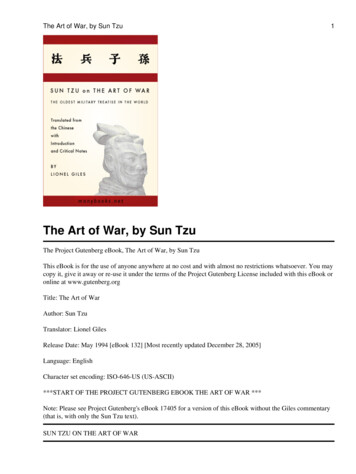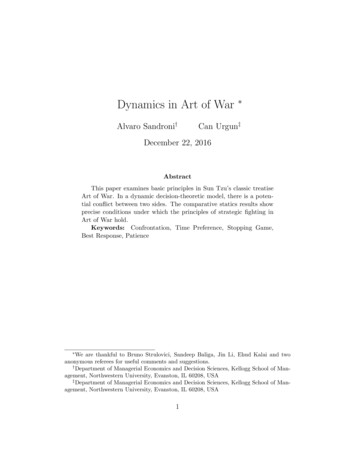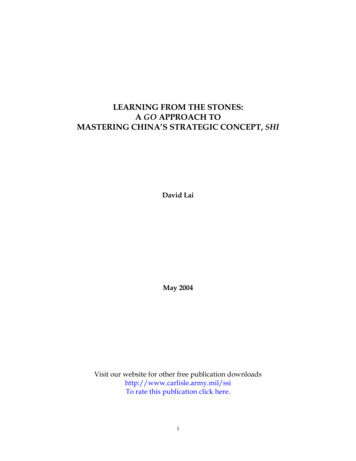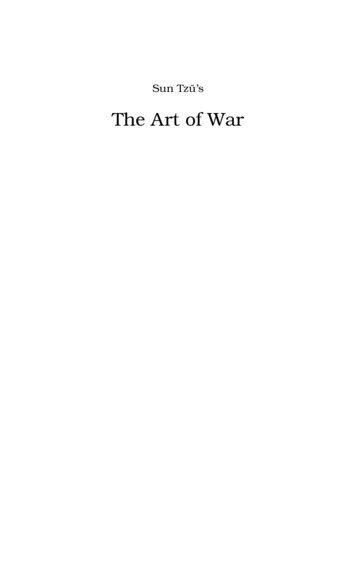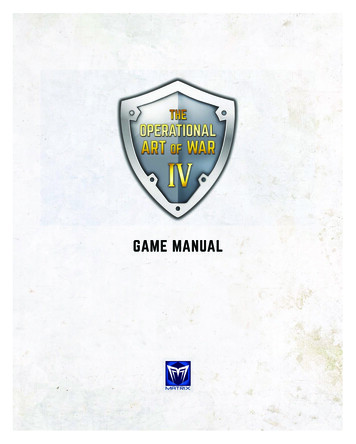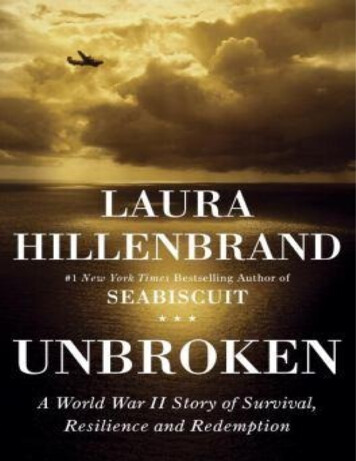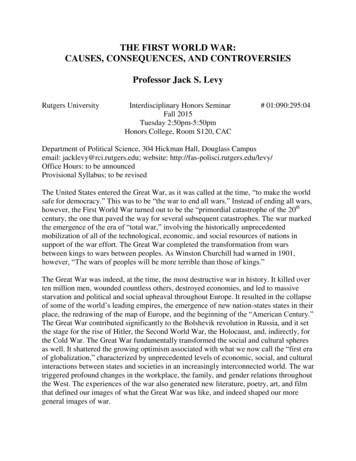
Transcription
The Art of War, by Sun Tzu1The Art of War, by Sun TzuThe Project Gutenberg eBook, The Art of War, by Sun TzuThis eBook is for the use of anyone anywhere at no cost and with almost no restrictions whatsoever. You maycopy it, give it away or re-use it under the terms of the Project Gutenberg License included with this eBook oronline at www.gutenberg.orgTitle: The Art of WarAuthor: Sun TzuTranslator: Lionel GilesRelease Date: May 1994 [eBook 132] [Most recently updated December 28, 2005]Language: EnglishCharacter set encoding: ISO-646-US (US-ASCII)***START OF THE PROJECT GUTENBERG EBOOK THE ART OF WAR ***Note: Please see Project Gutenberg's eBook 17405 for a version of this eBook without the Giles commentary(that is, with only the Sun Tzu text).SUN TZU ON THE ART OF WAR
The Art of War, by Sun Tzu2THE OLDEST MILITARY TREATISE IN THE WORLDTranslated from the Chinese with Introductionand Critical NotesBYLIONEL GILES, M.A.Assistant in the Department of Oriental Printed Books and MSS.in the British MuseumFirst Published in 1910To my brotherCaptain Valentine Giles, R.G.in the hope thata work 2400 years oldmay yet contain lessons worth considerationby the soldier of todaythis translationis affectionately dedicated.Preface to the Project Gutenburg EtextWhen Lionel Giles began his translation of Sun Tzu's ART OF WAR, the work was virtually unknown inEurope. Its introduction to Europe began in 1782 when a French Jesuit Father living in China, Joseph Amiot,acquired a copy of it, and translated it into French. It was not a good translation because, according to Dr.Giles, "[I]t contains a great deal that Sun Tzu did not write, and very little indeed of what he did."The first translation into English was published in 1905 in Tokyo by Capt. E. F. Calthrop, R.F.A. However,this translation is, in the words of Dr. Giles, "excessively bad." He goes further in this criticism: "It is notmerely a question of downright blunders, from which none can hope to be wholly exempt. Omissions werefrequent; hard passages were willfully distorted or slurred over. Such offenses are less pardonable. Theywould not be tolerated in any edition of a Latin or Greek classic, and a similar standard of honesty ought to beinsisted upon in translations from Chinese." In 1908 a new edition of Capt. Calthrop's translation waspublished in London. It was an improvement on the first -- omissions filled up and numerous mistakescorrected -- but new errors were created in the process. Dr. Giles, in justifying his translation, wrote: "It wasnot undertaken out of any inflated estimate of my own powers; but I could not help feeling that Sun Tzudeserved a better fate than had befallen him, and I knew that, at any rate, I could hardly fail to improve on thework of my predecessors."
The Art of War, by Sun Tzu3Clearly, Dr. Giles' work established much of the groundwork for the work of later translators who publishedtheir own editions. Of the later editions of the ART OF WAR I have examined; two feature Giles' editedtranslation and notes, the other two present the same basic information from the ancient Chinesecommentators found in the Giles edition. Of these four, Giles' 1910 edition is the most scholarly and presentsthe reader an incredible amount of information concerning Sun Tzu's text, much more than any othertranslation.The Giles' edition of the ART OF WAR, as stated above, was a scholarly work. Dr. Giles was a leadingsinologue at the time and an assistant in the Department of Oriental Printed Books and Manuscripts in theBritish Museum. Apparently he wanted to produce a definitive edition, superior to anything else that existedand perhaps something that would become a standard translation. It was the best translation available for 50years. But apparently there was not much interest in Sun Tzu in English- speaking countries since it took thestart of the Second World War to renew interest in his work. Several people published unsatisfactory Englishtranslations of Sun Tzu. In 1944, Dr. Giles' translation was edited and published in the United States in aseries of military science books. But it wasn't until 1963 that a good English translation (by Samuel B. Griffithand still in print) was published that was an equal to Giles' translation. While this translation is more lucidthan Dr. Giles' translation, it lacks his copious notes that make his so interesting.Dr. Giles produced a work primarily intended for scholars of the Chinese civilization and language. It containsthe Chinese text of Sun Tzu, the English translation, and voluminous notes along with numerous footnotes.Unfortunately, some of his notes and footnotes contain Chinese characters; some are completely Chinese.Thus, a conversion to a Latin alphabet etext was difficult. I did the conversion in complete ignorance ofChinese (except for what I learned while doing the conversion). Thus, I faced the difficult task ofparaphrasing it while retaining as much of the important text as I could. Every paraphrase represents a loss;thus I did what I could to retain as much of the text as possible. Because the 1910 text contains a Chineseconcordance, I was able to transliterate proper names, books, and the like at the risk of making the text moreobscure. However, the text, on the whole, is quite satisfactory for the casual reader, a transformation madepossible by conversion to an etext. However, I come away from this task with the feeling of loss because Iknow that someone with a background in Chinese can do a better job than I did; any such attempt would bewelcomed.Bob duINTRODUCTIONSun Wu and his BookSsu-ma Ch ien gives the following biography of Sun Tzu: [1]Sun Tzu Wu was a native of the Ch i State. His ART OF WAR brought him to the notice of Ho Lu, [2] Kingof Wu. Ho Lu said to him: "I have carefully perused your 13 chapters. May I submit your theory of managingsoldiers to a slight test?"Sun Tzu replied: "You may."Ho Lu asked: "May the test be applied to women?"
The Art of War, by Sun Tzu4The answer was again in the affirmative, so arrangements were made to bring 180 ladies out of the Palace.Sun Tzu divided them into two companies, and placed one of the King's favorite concubines at the head ofeach. He then bade them all take spears in their hands, and addressed them thus: "I presume you know thedifference between front and back, right hand and left hand?"The girls replied: Yes.Sun Tzu went on: "When I say "Eyes front," you must look straight ahead. When I say "Left turn," you mustface towards your left hand. When I say "Right turn," you must face towards your right hand. When I say"About turn," you must face right round towards your back."Again the girls assented. The words of command having been thus explained, he set up the halberds andbattle-axes in order to begin the drill. Then, to the sound of drums, he gave the order "Right turn." But thegirls only burst out laughing. Sun Tzu said: "If words of command are not clear and distinct, if orders are notthoroughly understood, then the general is to blame."So he started drilling them again, and this time gave the order "Left turn," whereupon the girls once moreburst into fits of laughter. Sun Tzu: "If words of command are not clear and distinct, if orders are notthoroughly understood, the general is to blame. But if his orders ARE clear, and the soldiers neverthelessdisobey, then it is the fault of their officers."So saying, he ordered the leaders of the two companies to be beheaded. Now the king of Wu was watching thescene from the top of a raised pavilion; and when he saw that his favorite concubines were about to beexecuted, he was greatly alarmed and hurriedly sent down the following message: "We are now quite satisfiedas to our general's ability to handle troops. If We are bereft of these two concubines, our meat and drink willlose their savor. It is our wish that they shall not be beheaded."Sun Tzu replied: "Having once received His Majesty's commission to be the general of his forces, there arecertain commands of His Majesty which, acting in that capacity, I am unable to accept."Accordingly, he had the two leaders beheaded, and straightway installed the pair next in order as leaders intheir place. When this had been done, the drum was sounded for the drill once more; and the girls wentthrough all the evolutions, turning to the right or to the left, marching ahead or wheeling back, kneeling orstanding, with perfect accuracy and precision, not venturing to utter a sound. Then Sun Tzu sent a messengerto the King saying: "Your soldiers, Sire, are now properly drilled and disciplined, and ready for your majesty'sinspection. They can be put to any use that their sovereign may desire; bid them go through fire and water,and they will not disobey."But the King replied: "Let our general cease drilling and return to camp. As for us, We have no wish to comedown and inspect the troops."Thereupon Sun Tzu said: "The King is only fond of words, and cannot translate them into deeds."After that, Ho Lu saw that Sun Tzu was one who knew how to handle an army, and finally appointed himgeneral. In the west, he defeated the Ch u State and forced his way into Ying, the capital; to the north he putfear into the States of Ch i and Chin, and spread his fame abroad amongst the feudal princes. And Sun Tzushared in the might of the King.About Sun Tzu himself this is all that Ssu-ma Ch ien has to tell us in this chapter. But he proceeds to give abiography of his descendant, Sun Pin, born about a hundred years after his famous ancestor's death, and alsothe outstanding military genius of his time. The historian speaks of him too as Sun Tzu, and in his preface weread: "Sun Tzu had his feet cut off and yet continued to discuss the art of war." [3] It seems likely, then, that
The Art of War, by Sun Tzu5"Pin" was a nickname bestowed on him after his mutilation, unless the story was invented in order to accountfor the name. The crowning incident of his career, the crushing defeat of his treacherous rival P ang Chuan,will be found briefly related in Chapter V. ss. 19, note.To return to the elder Sun Tzu. He is mentioned in two other passages of the SHIH CHI: -In the third year of his reign [512 B.C.] Ho Lu, king of Wu, took the field with Tzu-hsu [i.e. Wu Yuan] and PoP ei, and attacked Ch u. He captured the town of Shu and slew the two prince's sons who had formerly beengenerals of Wu. He was then meditating a descent on Ying [the capital]; but the general Sun Wu said: "Thearmy is exhausted. It is not yet possible. We must wait". [After further successful fighting,] "in the ninthyear [506 B.C.], King Ho Lu addressed Wu Tzu-hsu and Sun Wu, saying: "Formerly, you declared that it wasnot yet possible for us to enter Ying. Is the time ripe now?" The two men replied: "Ch u's general Tzu-ch ang,[4] is grasping and covetous, and the princes of T ang and Ts ai both have a grudge against him. If YourMajesty has resolved to make a grand attack, you must win over T ang and Ts ai, and then you may succeed."Ho Lu followed this advice, [beat Ch u in five pitched battles and marched into Ying.] [5]This is the latest date at which anything is recorded of Sun Wu. He does not appear to have survived hispatron, who died from the effects of a wound in 496.In another chapter there occurs this passage: [6]From this time onward, a number of famous soldiers arose, one after the other: Kao-fan, [7] who wasemployed by the Chin State; Wang-tzu, [8] in the service of Ch i; and Sun Wu, in the service of Wu. Thesemen developed and threw light upon the principles of war.It is obvious enough that Ssu-ma Ch ien at least had no doubt about the reality of Sun Wu as an historicalpersonage; and with one exception, to be noticed presently, he is by far the most important authority on theperiod in question. It will not be necessary, therefore, to say much of such a work as the WU YUEH CH UNCH IU, which is supposed to have been written by Chao Yeh of the 1st century A.D. The attribution issomewhat doubtful; but even if it were otherwise, his account would be of little value, based as it is on theSHIH CHI and expanded with romantic details. The story of Sun Tzu will be found, for what it is worth, inchapter 2. The only new points in it worth noting are: (1) Sun Tzu was first recommended to Ho Lu by WuTzu-hsu. (2) He is called a native of Wu. (3) He had previously lived a retired life, and his contemporarieswere unaware of his ability.The following passage occurs in the Huai-nan Tzu: "When sovereign and ministers show perversity of mind,it is impossible even for a Sun Tzu to encounter the foe." Assuming that this work is genuine (and hitherto nodoubt has been cast upon it), we have here the earliest direct reference for Sun Tzu, for Huai-nan Tzu died in122 B.C., many years before the SHIH CHI was given to the world.Liu Hsiang (80-9 B.C.) says: "The reason why Sun Tzu at the head of 30,000 men beat Ch u with 200,000 isthat the latter were undisciplined."Teng Ming-shih informs us that the surname "Sun" was bestowed on Sun Wu's grandfather by Duke Ching ofCh i [547-490 B.C.]. Sun Wu's father Sun P ing, rose to be a Minister of State in Ch i, and Sun Wu himself,whose style was Ch ang-ch ing, fled to Wu on account of the rebellion which was being fomented by thekindred of T ien Pao. He had three sons, of whom the second, named Ming, was the father of Sun Pin.According to this account then, Pin was the grandson of Wu, which, considering that Sun Pin's victory overWei was gained in 341 B.C., may be dismissed as chronological impossible. Whence these data were obtainedby Teng Ming-shih I do not know, but of course no reliance whatever can be placed in them.An interesting document which has survived from the close of the Han period is the short preface written by
The Art of War, by Sun Tzu6the Great Ts ao Ts ao, or Wei Wu Ti, for his edition of Sun Tzu. I shall give it in full: -I have heard that the ancients used bows and arrows to their advantage. [10] The SHU CHU mentions "thearmy" among the "eight objects of government." The I CHING says: "'army' indicates firmness and justice;the experienced leader will have good fortune." The SHIH CHING says: "The King rose majestic in his wrath,and he marshaled his troops." The Yellow Emperor, T ang the Completer and Wu Wang all used spears andbattle-axes in order to succor their generation. The SSU-MA FA says: "If one man slay another of set purpose,he himself may rightfully be slain." He who relies solely on warlike measures shall be exterminated; he whorelies solely on peaceful measures shall perish. Instances of this are Fu Ch ai [11] on the one hand and YenWang on the other. [12] In military matters, the Sage's rule is normally to keep the peace, and to move hisforces only when occasion requires. He will not use armed force unless driven to it by necessity.Many books have I read on the subject of war and fighting; but the work composed by Sun Wu is theprofoundest of them all. [Sun Tzu was a native of the Ch i state, his personal name was Wu. He wrote theART OF WAR in 13 chapters for Ho Lu, King of Wu. Its principles were tested on women, and he wassubsequently made a general. He led an army westwards, crushed the Ch u state and entered Ying the capital.In the north, he kept Ch i and Chin in awe. A hundred years and more after his time, Sun Pin lived. He was adescendant of Wu.] [13] In his treatment of deliberation and planning, the importance of rapidity in taking thefield, [14] clearness of conception, and depth of design, Sun Tzu stands beyond the reach of carping criticism.My contemporaries, however, have failed to grasp the full meaning of his instructions, and while putting intopractice the smaller details in which his work abounds, they have overlooked its essential purport. That is themotive which has led me to outline a rough explanation of the whole.One thing to be noticed in the above is the explicit statement that the 13 chapters were specially composed forKing Ho Lu. This is supported by the internal evidence of I. ss. 15, in which it seems clear that some ruler isaddressed.In the bibliographic section of the HAN SHU, there is an entry which has given rise to much discussion: "Theworks of Sun Tzu of Wu in 82 P IEN (or chapters), with diagrams in 9 CHUAN." It is evident that this cannotbe merely the 13 chapters known to Ssu-ma Ch ien, or those we possess today. Chang Shou-chieh refers to anedition of Sun Tzu's ART OF WAR of which the "13 chapters" formed the first CHUAN, adding that therewere two other CHUAN besides. This has brought forth a theory, that the bulk of these 82 chapters consistedof other writings of Sun Tzu -- we should call them apocryphal -- similar to the WEN TA, of which aspecimen dealing with the Nine Situations [15] is preserved in the T UNG TIEN, and another in Ho Shin'scommentary. It is suggested that before his interview with Ho Lu, Sun Tzu had only written the 13 chapters,but afterwards composed a sort of exegesis in the form of question and answer between himself and the King.Pi I-hsun, the author of the SUN TZU HSU LU, backs this up with a quotation from the WU YUEH CH UNCH IU: "The King of Wu summoned Sun Tzu, and asked him questions about the art of war. Each time he setforth a chapter of his work, the King could not find words enough to praise him." As he points out, if thewhole work was expounded on the same scale as in the above- mentioned fragments, the total number ofchapters could not fail to be considerable. Then the numerous other treatises attributed to Sun Tzu might beincluded. The fact that the HAN CHIH mentions no work of Sun Tzu except the 82 P IEN, whereas the Suiand T ang bibliographies give the titles of others in addition to the "13 chapters," is good proof, Pi I-hsunthinks, that all of these were contained in the 82 P IEN. Without pinning our faith to the accuracy of detailssupplied by the WU YUEH CH UN CH IU, or admitting the genuineness of any of the treatises cited by PiI-hsun, we may see in this theory a probable solution of the mystery. Between Ssu-ma Ch ien and Pan Kuthere was plenty of time for a luxuriant crop of forgeries to have grown up under the magic name of Sun Tzu,and the 82 P IEN may very well represent a collected edition of these lumped together with the original work.It is also possible, though less likely, that some of them existed in the time of the earlier historian and werepurposely ignored by him. [16]Tu Mu's conjecture seems to be based on a passage which states: "Wei Wu Ti strung together Sun Wu's Art of
The Art of War, by Sun Tzu7War," which in turn may have resulted from a misunderstanding of the final words of Ts ao King's preface.This, as Sun Hsing-yen points out, is only a modest way of saying that he made an explanatory paraphrase, orin other words, wrote a commentary on it. On the whole, this theory has met with very little acceptance. Thus,the SSU K U CH UAN SHU says: "The mention of the 13 chapters in the SHIH CHI shows that they were inexistence before the HAN CHIH, and that latter accretions are not to be considered part of the original work.Tu Mu's assertion can certainly not be taken as proof."There is every reason to suppose, then, that the 13 chapters existed in the time of Ssu-ma Ch ien practically aswe have them now. That the work was then well known he tells us in so many words. "Sun Tzu's 13 Chaptersand Wu Ch i's Art of War are the two books that people commonly refer to on the subject of military matters.Both of them are widely distributed, so I will not discuss them here." But as we go further back, seriousdifficulties begin to arise. The salient fact which has to be faced is that the TSO CHUAN, the greatestcontemporary record, makes no mention whatsoever of Sun Wu, either as a general or as a writer. It is natural,in view of this awkward circumstance, that many scholars should not only cast doubt on the story of Sun Wuas given in the SHIH CHI, but even show themselves frankly skeptical as to the existence of the man at all.The most powerful presentment of this side of the case is to be found in the following disposition by YehShui-hsin: [17] -It is stated in Ssu-ma Ch ien's history that Sun Wu was a native of the Ch i State, and employed by Wu; andthat in the reign of Ho Lu he crushed Ch u, entered Ying, and was a great general. But in Tso's Commentaryno Sun Wu appears at all. It is true that Tso's Commentary need not contain absolutely everything that otherhistories contain. But Tso has not omitted to mention vulgar plebeians and hireling ruffians such as YingK ao-shu, [18] Ts ao Kuei, [19], Chu Chih-wu and Chuan She-chu [20]. In the case of Sun Wu, whose fameand achievements were so brilliant, the omission is much more glaring. Again, details are given, in their dueorder, about his contemporaries Wu Yuan and the Minister P ei. [21] Is it credible that Sun Wu alone shouldhave been passed over?In point of literary style, Sun Tzu's work belongs to the same school as KUAN TZU, [22] LIU T AO, [23] andthe YUEH YU [24] and may have been the production of some private scholar living towards the end of the"Spring and Autumn" or the beginning of the "Warring States" period. [25] The story that his precepts wereactually applied by the Wu State, is merely the outcome of big talk on the part of his followers.From the flourishing period of the Chou dynasty [26] down to the time of the "Spring and Autumn," allmilitary commanders were statesmen as well, and the class of professional generals, for conducting externalcampaigns, did not then exist. It was not until the period of the "Six States" [27] that this custom changed.Now although Wu was an uncivilized State, it is conceivable that Tso should have left unrecorded the fact thatSun Wu was a great general and yet held no civil office? What we are told, therefore, about Jang-chu [28] andSun Wu, is not authentic matter, but the reckless fabrication of theorizing pundits. The story of Ho Lu'sexperiment on the women, in particular, is utterly preposterous and incredible.Yeh Shui-hsin represents Ssu-ma Ch ien as having said that Sun Wu crushed Ch u and entered Ying. This isnot quite correct. No doubt the impression left on the reader's mind is that he at least shared in these exploits.The fact may or may not be significant; but it is nowhere explicitly stated in the SHIH CHI either that SunTzu was general on the occasion of the taking of Ying, or that he even went there at all. Moreover, as weknow that Wu Yuan and Po P ei both took part in the expedition, and also that its success was largely due tothe dash and enterprise of Fu Kai, Ho Lu's younger brother, it is not easy to see how yet another general couldhave played a very prominent part in the same campaign.Ch en Chen-sun of the Sung dynasty has the note: -Military writers look upon Sun Wu as the father of their art. But the fact that he does not appear in the TSOCHUAN, although he is said to have served under Ho Lu King of Wu, makes it uncertain what period he
The Art of War, by Sun Tzu8really belonged to.He also says: -The works of Sun Wu and Wu Ch i may be of genuine antiquity.It is noticeable that both Yeh Shui-hsin and Ch en Chen-sun, while rejecting the personality of Sun Wu as hefigures in Ssu-ma Ch ien's history, are inclined to accept the date traditionally assigned to the work whichpasses under his name. The author of the HSU LU fails to appreciate this distinction, and consequently hisbitter attack on Ch en Chen-sun really misses its mark. He makes one of two points, however, which certainlytell in favor of the high antiquity of our "13 chapters." "Sun Tzu," he says, "must have lived in the age ofChing Wang [519-476], because he is frequently plagiarized in subsequent works of the Chou, Ch in and Handynasties." The two most shameless offenders in this respect are Wu Ch i and Huai-nan Tzu, both of themimportant historical personages in their day. The former lived only a century after the alleged date of Sun Tzu,and his death is known to have taken place in 381 B.C. It was to him, according to Liu Hsiang, that TsengShen delivered the TSO CHUAN, which had been entrusted to him by its author. [29] Now the fact thatquotations from the ART OF WAR, acknowledged or otherwise, are to be found in so many authors ofdifferent epochs, establishes a very strong anterior to them all, -- in other words, that Sun Tzu's treatise wasalready in existence towards the end of the 5th century B.C. Further proof of Sun Tzu's antiquity is furnishedby the archaic or wholly obsolete meanings attaching to a number of the words he uses. A list of these, whichmight perhaps be extended, is given in the HSU LU; and though some of the interpretations are doubtful, themain argument is hardly affected thereby. Again, it must not be forgotten that Yeh Shui- hsin, a scholar andcritic of the first rank, deliberately pronounces the style of the 13 chapters to belong to the early part of thefifth century. Seeing that he is actually engaged in an attempt to disprove the existence of Sun Wu himself, wemay be sure that he would not have hesitated to assign the work to a later date had he not honestly believedthe contrary. And it is precisely on such a point that the judgment of an educated Chinaman will carry mostweight. Other internal evidence is not far to seek. Thus in XIII. ss. 1, there is an unmistakable allusion to theancient system of land-tenure which had already passed away by the time of Mencius, who was anxious to seeit revived in a modified form. [30] The only warfare Sun Tzu knows is that carried on between the variousfeudal princes, in which armored chariots play a large part. Their use seems to have entirely died out beforethe end of the Chou dynasty. He speaks as a man of Wu, a state which ceased to exist as early as 473 B.C. Onthis I shall touch presently.But once refer the work to the 5th century or earlier, and the chances of its being other than a bona fideproduction are sensibly diminished. The great age of forgeries did not come until long after. That it shouldhave been forged in the period immediately following 473 is particularly unlikely, for no one, as a rule,hastens to identify himself with a lost cause. As for Yeh Shui-hsin's theory, that the author was a literaryrecluse, that seems to me quite untenable. If one thing is more apparent than another after reading the maximsof Sun Tzu, it is that their essence has been distilled from a large store of personal observation and experience.They reflect the mind not only of a born strategist, gifted with a rare faculty of generalization, but also of apractical soldier closely acquainted with the military conditions of his time. To say nothing of the fact thatthese sayings have been accepted and endorsed by all the greatest captains of Chinese history, they offer acombination of freshness and sincerity, acuteness and common sense, which quite excludes the idea that theywere artificially concocted in the study. If we admit, then, that the 13 chapters were the genuine production ofa military man living towards the end of the "CH UN CH IU" period, are we not bound, in spite of the silenceof the TSO CHUAN, to accept Ssu-ma Ch ien's account in its entirety? In view of his high repute as a soberhistorian, must we not hesitate to assume that the records he drew upon for Sun Wu's biography were falseand untrustworthy? The answer, I fear, must be in the negative. There is still one grave, if not fatal, objectionto the chronology involved in the story as told in the SHIH CHI, which, so far as I am aware, nobody has yetpointed out. There are two passages in Sun Tzu in which he alludes to contemporary affairs. The first in in VI.ss. 21: --
The Art of War, by Sun Tzu9Though according to my estimate the soldiers of Yueh exceed our own in number, that shall advantage themnothing in the matter of victory. I say then that victory can be achieved.The other is in XI. ss. 30: -Asked if an army can be made to imitate the SHUAI-JAN, I should answer, Yes. For the men of Wu and themen of Yueh are enemies; yet if they are crossing a river in the same boat and are caught by a storm, they willcome to each other's assistance just as the left hand helps the right.These two paragraphs are extremely valuable as evidence of the date of composition. They assign the work tothe period of the struggle between Wu and Yueh. So much has been observed by Pi I-hsun. But what hashitherto escaped notice is that they also seriously impair the credibility of Ssu-ma Ch ien's narrative. As wehave seen above, the first positive date given in connection with Sun Wu is 512 B.C. He is then spoken of as ageneral, acting as confidential adviser to Ho Lu, so that his alleged introduction to that monarch had alreadytaken place, and of course the 13 chapters must have been written earlier still. But at that time, and for severalyears after, down to the capture of Ying in 506, Ch u and not Yueh, was the great hereditary enemy of Wu.The two states, Ch u and Wu, had been constantly at war for over half a century, [31] whereas the first warbetween Wu and Yueh was waged only in 510, [32] and even then was no more than a short interludesandwiched in the midst of the fierce struggle with Ch u. Now Ch u is not mentioned in the 13 chapters at all.The natural inference is that they were written at a time when Yueh had become the prime antagonist of Wu,that is, after Ch u had suffered the great humiliation of 506. At this point, a table of dates may be founduseful.B.C. 514 Accession of Ho Lu. 512 Ho Lu attacks Ch u, but is dissuaded from entering Ying, the capital. SHI CHI mentions Sun Wu as general. 511 Another attack on Ch u. 510 Wu makes asuccessful attack on Yueh. This is the first war between the two states. 509 or Ch u invades Wu, but is signally defeated at Yu-chang. 508 506 HoLu attacks Ch u with the aid of T ang and Ts ai. Decisive batt
The Art of War, by Sun Tzu The Project Gutenberg eBook, The Art of War, by Sun Tzu This eBook is for the use of anyone anywhere at no cost and with almost no restrictions whatsoever. You may copy it, give it away or re-use it under the terms of the Project Gutenberg License included with this eBook or online at www.gutenberg.org Title: The Art .File Size: 505KBPage Count: 96Explore furtherThe Art of War by Sun Tzu - Downloadsuntzusaid.comArt of War by Sun Tzu - Free eBook Onlinewww.literatureproject.comThe Art of War : Sun Tzu : Free Download, Borrow, and .archive.orgThe 33 Strategies Of War : Free Download, Borrow, and .archive.orgThe Art Of War EBook PDF, EPUB, MOBI, AZW3 - SNEWDsnewd.comRecommended to you b


